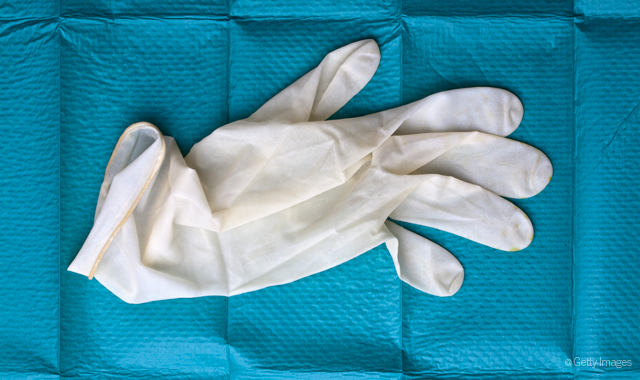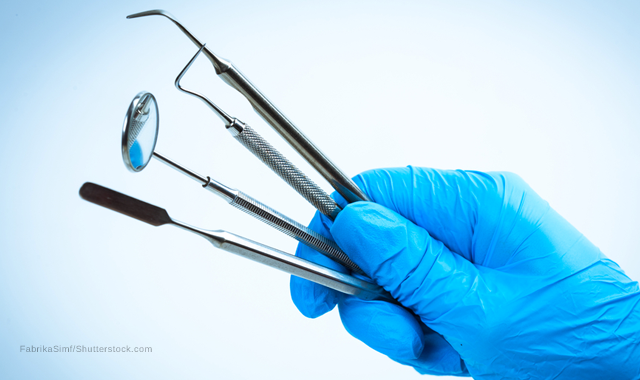4 Extreme Measures Taken in the Name of Infection Control
Sometimes dental practices make their lives more difficult than they need to.
Too often we hear stories about how practices fell short when it came to proper infection control. However, sometimes the pendulum swings just as far the other direction.

Sometimes the result can cause its own problem, but other times the practices are just making their lives more difficult than they need to.
Trending article: The 5 worst ways to ask for a raise
Here are four stories about infection control gone to the extreme.

Extreme safeguards
In the 1980s, AIDS was a new public health threat. We know a lot about it now, but three decades ago, it was a deadly mystery.
“Nobody had connected the dots yet,” says Doug Braendle, product manager at SciCan. “They knew it was a disease. The CDC was trying as best they could to figure it out. Nobody had any idea.”
Treating patients with AIDS posed a serious challenge for health care professionals.
Related article: 5 things you should be doing NOW to improve infection control
“There were AIDS patients who, obviously, were seeking medical and dental care,” he continues. “I was in a small town in the center part of Pennsylvania, and I called on this one office. The doctor was getting ready to see an AIDS patient, and, again, they didn’t know what the infection control protocols were. They didn’t know what to do. I was in the office talking to him and this appointment was going to come in at 5 o’clock.”
Not knowing how best to treat an AIDS patient, the doctor did the best that he could.
“He had let go all of his staff. It was just going to be him and literally the entire operatory – the chairs, the lights, everything – was draped in plastic,” Braendle remembers. “This entire room was covered in plastic because, God bless this guy, he knew this person needed dental care. Was that an overreaction? I’m sure it was, but back in the day, God bless him for actually doing that than turning the patient away and saying, ‘No, I’m not going to see you.’”

Extreme individual attention
While Braendle’s experience was somewhat unique because there were no established protocols in place for AIDS patients at the time, standard protocols do exist.
Dr. Marie Fluent, DDS, an educational consultant for the Organization for Safety, Asepsis and Prevention (OSAP), recounts an incident that occurred while she was in practice. After seeing a patient who was a hepatitis B carrier, she observed an assistant going to unusual lengths to clean and sterilize.
“After the procedure, I was in the sterilization room and saw my dental assistant processing instruments in a way that was not familiar to me,” Dr. Fluent remembers. “And I asked her, ‘What are you doing?’ She was doing things that she considered above and beyond the call of duty because he was a hepatitis B carrier.”
She was wrapping the instruments first and then sterilizing them, unwrapping them, then washing them, then putting them through the ultrasonic, and then rewrapping and sterilizing again.
More from the author: 10 easy ways to get CE credit
“The assistant considered that to be above and beyond the call of duty, as an extra-safe measure,” Dr. Fluent says. “So, I looked at her and said, ‘What about Standard Precautions?’ And, as you know, Standard Precautions mean that we treat all patients and all dental instruments exactly the same way each and every time, no matter what the medical history says. She said, ‘I understand Standard Precautions, but this time we know that he’s a hepatitis B carrier.’”
Dr. Fluent and her assistant continued their discussion about the meaning of “Standard Precautions,” with the assistant maintaining that – in this case – something extra was necessary.
“We went back and forth like that several times and finally she said, ‘Okay, I get it,’” she adds. “I found that interesting because we worked together for 15 years and I thought she understood Standard Precautions, since she attended a formal dental assisting program and was trained by me. Yet, she thought her extra precautions were in all our best interests. But the reality is, if you deviate from Standard Precautions, your instruments are not processed the same each and every time, and you’ve totally thrown the concept out of the window.”
It became a teachable moment at her practice and an opportunity to revisit the concept of “Standard Precautions” with everyone.
“When it comes to compliance it’s everybody’s responsibility,” Dr. Fluent says. “You have to create a culture of safety, so everybody feels free to talk about anything within the infection control program. And if I did bring up a compliance-related topic at a meeting, I wasn’t reprimanding or embarrassing her in front of her colleagues. Everybody should feel free to comment and share and help each other with compliance and nobody should be feeling singled-out or threatened at all.”

Extreme disinfection
When disinfecting a surface, it’s necessary to follow the manufacturer’s directions when using a product. However, in rare occasions, a practice may do more than is necessary.
Dr. Fluent consults with a dental office that uses trays for their delivery system. The trays, she says, should be cleaned and disinfected with a surface disinfectant between patients – that is all that is required.
Trending research: Study finds technology allows remote diagnosis of cleft palate patients
“But this office uses a barrier protection in addition to using an intermediate-level surface disinfectant,” Dr. Fluent says. “They apply a plastic wrap to protect each tray, and then the plastic barrier is removed and the tray is cleaned and disinfected in between. I questioned it, and the owner dentist is aware that this is above and beyond the call of duty; however, she felt more comfortable providing both the barrier and the surface disinfectant. If this dentist chose to wrap trays AND utilize a surface disinfectant for SOME patients due to specific information on health histories, this would be a problem, as it does not conform to Standard Precautions. However, as long as this was the office policy, a facility-specific policy, and she did it for all of the trays, for every patient, that’s fine, and we just let it go.
“It’s not in contradiction with CDC guidelines for any other infection control protocols,” she adds. “It’s not necessary, but it’s not hurting anybody.”
Braendle, too, has encountered practices unnecessarily duplicating their efforts.
One practice he visited was cleaning everything down with one brand of disinfectant, and then going back over it all again with SciCan’s OPTIM disinfectant.
“Why are you doing in a second time?” Braendle wonders. “Any one of those products, as long as you’re following the instructions for the product, is fine. You’re just doubling up. As long as you’re doing everything properly, you’re taking care of everything.”
“We tell people – with sterilization and also bugs on the countertop – when you’re doing proper disinfection, ‘dead is dead.’”

Extreme rule following
There are plenty of rules to follow when it comes to infection control. However, practices need to make sure they’re following the rules appropriate to them.
“In 2003, the CDC came out with their guidelines for the dental office,” Braendle says. “And then, in 2016, there was an update. When you’re a regular dental office, the CDC makes these guidelines. They don’t have enforcement police. There is no one who goes around from office to office and shows you a badge and says, ‘I’m from CDC in Atlanta and I’m here to check your infection control protocols.’
“Each individual state has the option of adopting their own infection control guidelines, or they adopt CDC guidelines, and that’s where the enforcement comes in,” he continues. “The state can come in and say, ‘Hey, are you doing these things?’”
Related article: 5 benefits of good infection control
But some facilities are governed by another authority altogether.
“There is a regulatory group called the Joint Commission,” Braendle explains. “Those people will come in and go through an office and make sure you are doing everything as far as Joint Commission is concerned. Right now, those are only federal dental facilities, state-run dental facilities, and – as of last year – military facilities.”
But Joint Commission doesn’t establish the rules for everyone, and sometimes that is misunderstood.
“Where it really gets weird is when you go to these dental meetings, and every once in a while, you’ll have one of these federal people up there teaching a class or a seminar about the things that you should do or not do,” Braendle says. “And when they’re talking to a group of GPs, you almost want to run up and say, ‘Shut up. Know your audience. Not everybody is subject to Joint Commission. They’re not a government-run organization. Everything you’re telling them they have to do, they don’t have to do any of that stuff.’
“If there gets to be anymore blurring of who is responsible for what, sometimes these offices are left in the lurch,” he continues. “They listen to these speakers and think, ‘I’m going to have to do this.’ Well, no you don’t. Those are the guidelines that you have to work under.”
The most prevalent problem we hear about in infection control is practices not doing what they should do. On the flipside of that coin, sometimes practices are doing too much. At best, they’re making their own work more difficult. At worst, they may be causing additional problems.